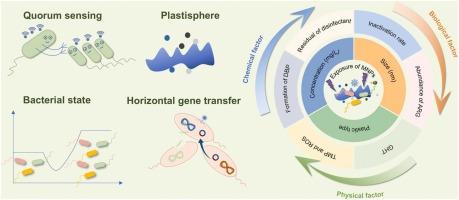Reassessing systemic blind spots in modern water disinfection paradigms
IF 11.3
1区 环境科学与生态学
Q1 ENGINEERING, ENVIRONMENTAL
引用次数: 0
Abstract
Disinfection plays a crucial role in ensuring healthcare and the safety of drinking water and sewage reuse. However, our current understanding of the factors influencing disinfection remains incomplete. This review offers a comprehensive examination of the often-neglected aspects in disinfection, such as micro- and nanoplastics (MNPs), bacterial states, quorum sensing, and horizontal gene transfer. A meta-analysis was conducted to evaluate the exposure risk and impacts associated with MNPs in water disinfection systems. Our findings indicate that within a specific concentration range of 5 μg·L−1 to 11.43 g·L−1, higher concentrations of MNPs hinder the bacterial inactivation rate and significantly increase the frequency of horizontal gene transfer following disinfection. Furthermore, MNPs also promote the formation of disinfection by-products (DBPs), with larger size of MNPs having a stronger effect. Among the various types of MNPs, studies predominantly focus on the response of polyethylene, and polyethylene terephthalate caused distinct promotion of DBPs. Our review also highlights existing knowledge gaps and challenges in the disinfection processes and facilitates the assessment of the risk of these influence factors, thereby supporting the development of advanced disinfection technologies. Additionally, it suggests prospective research directions in the field of water disinfection, aiming at improving disinfection processes.

重新评估现代水消毒范式中的系统盲点
消毒在确保卫生保健和饮用水安全以及污水回用方面发挥着至关重要的作用。然而,我们目前对影响消毒的因素的了解仍然不完整。本文综述了消毒中经常被忽视的方面,如微塑料和纳米塑料(MNPs)、细菌状态、群体感应和水平基因转移。进行了一项荟萃分析,以评估与水消毒系统中MNPs相关的暴露风险和影响。结果表明,在5 μg·L-1 ~ 11.43 g·L-1的特定浓度范围内,MNPs浓度越高,细菌灭活率越低,消毒后水平基因转移频率越高。此外,MNPs还促进消毒副产物(DBPs)的形成,MNPs的大小越大,作用越强。在不同类型的MNPs中,研究主要集中在聚乙烯的响应上,聚对苯二甲酸乙二醇酯对DBPs的促进作用明显。我们的综述还强调了消毒过程中现有的知识差距和挑战,并促进了这些影响因素的风险评估,从而支持了先进消毒技术的发展。并提出了水消毒领域的未来研究方向,以改进消毒工艺为目标。
本文章由计算机程序翻译,如有差异,请以英文原文为准。
求助全文
约1分钟内获得全文
求助全文
来源期刊

Journal of Hazardous Materials
工程技术-工程:环境
CiteScore
25.40
自引率
5.90%
发文量
3059
审稿时长
58 days
期刊介绍:
The Journal of Hazardous Materials serves as a global platform for promoting cutting-edge research in the field of Environmental Science and Engineering. Our publication features a wide range of articles, including full-length research papers, review articles, and perspectives, with the aim of enhancing our understanding of the dangers and risks associated with various materials concerning public health and the environment. It is important to note that the term "environmental contaminants" refers specifically to substances that pose hazardous effects through contamination, while excluding those that do not have such impacts on the environment or human health. Moreover, we emphasize the distinction between wastes and hazardous materials in order to provide further clarity on the scope of the journal. We have a keen interest in exploring specific compounds and microbial agents that have adverse effects on the environment.
 求助内容:
求助内容: 应助结果提醒方式:
应助结果提醒方式:


